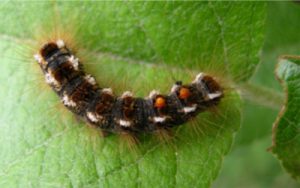Any day now, over-wintered Browntail Moth caterpillars will start to emerge from their tree-top leaf nests and start eating. Last year they did a great job (?) of defoliating Oak trees around Clary Lake and spreading their poisonous hairs all over the place. The south shore of the lake by Hodsdon Lane was particularly hard hit. I haven’t seen near as many Browntail moth nests in the trees around my house this spring, making me think this year the infestation may be less severe than last year, but it still pays to be alert to the risk they pose to our trees and our health. According to the newly published Browntail Moth Risk Map (PDF | 2.44 MB) however, the towns of Whitefield and Jefferson still have a HIGH Browntail Moth Risk Rating.
Here’s a link to the State of Maine Department of Agriculture, Conservation, & Forestry’s information page about Browntail Moths.
Maine Department of Agriculture, Conservation & Forestry: Browntail Moths
The Maine CDC and the Maine Forest Service have also issued a spring warning:
Maine People Urged to Take Precautions Against Browntail Moth Hairs When Outside
“The greatest risk for exposure to the toxic hairs is from now through July when the moths are active. The hairs can land anywhere, including on trees, gardens, lawns, and decks. The hairs remain toxic in the environment for one to three years, and can be stirred up by activities like mowing, raking, and sweeping.”
Everyone stay safe out there.

